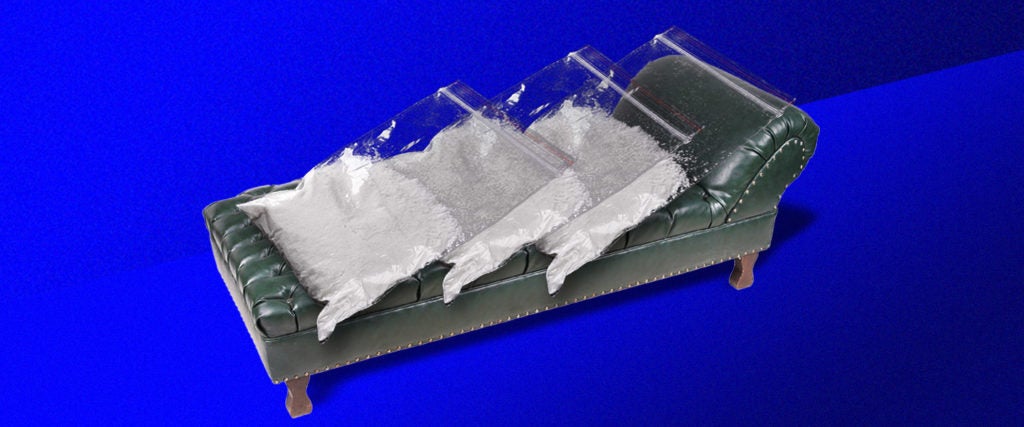If Sigmund Freud loved anything more than spooning with his mom, it was white, powdery cocaine. He loved coke so much, at the peak of his addiction in 1895, a doctor had to shove a hot knife into his nasal cavity to burn a hole in the congested tissues after Freud snorted too much blow. Yet, during this same timeframe, the Austrian neurologist was developing the “talking cure” in order to treat mental afflictions of the era, like hysteria.
Freud believed that we aren’t conscious of the majority of what’s going on in our minds, and in order to uncover more clues about why we are the way we are, we have to dig into our psyches for clues. One effective, timeless way to do that is sprawled out on a couch (yet another Freudian affectation), talking it out. Many experts agree that this laid the groundwork for psychoanalytic theory and modern psychotherapy.
But as much as therapy has been found to be vital for many people who struggle with their mental health, in retrospect, the premise does seem super coked-up. Really, the only thing cokier than Freud suggesting, “Dude, what if we just fucking talked until we feel better?” would’ve been if he made you read his screenplay afterwards.
Physician and medical historian Howard Markel, who wrote the book An Anatomy of Addiction, which explores how cocaine almost destroyed the careers of Freud and surgeon William Halsted, likewise suspects that the drug played a role in the origins of talk therapy. “Freud loved the way cocaine made him feel, and he was very interested in its psychological components. For one, it did make him feel better when he was sad. He also was amazed at how it made him talk about things endlessly that he thought were locked away in his brain,” Markel told the PBS NewsHour in 2011. “Sound familiar? That’s talk therapy, but without the toxic side effects of cocaine.” In case that wasn’t clear enough, Markel reiterated the point: “The idea of talk therapy, where you talk freely or free associate from one thing to another, may have been inspired by the cocaine unleashing his tongue.”
In Freud’s defense, cocaine was legal and easily available over-the-counter. But although plenty of people were doing it, it wasn’t the subject of much psychological inquiry. Freud was trying to change that by testing it out on himself. “Freud had ingested dozens of cocaine doses, ranging from .05 to .10 grams, over the span of several weeks,” Sam Nabil, therapist and CEO of Naya Clinics, tells me. While cocaine is known to impair cognitive abilities, “the substance also provided the infamous psychological icon a boost of clarity that he effectively used to fuel up all of his other theories,” Nabil explains.
And sure, experimenting on yourself with cocaine in today’s world seems like bullshit, but early on in his dabbling, his work was pretty groundbreaking. Freud’s comprehensive 1884 study “Über Coca” — which recounted his own firsthand experiences with being talkative on the drug, along with other insights — is still frequently cited today.
Like any good coked-up idea, it wasn’t entirely original, but it wasn’t stolen either. Although Freud is considered the father of psychoanalysis, the idea started with Freud’s mentor, physician Josef Breuer, who found that talking about repressed trauma helped treat his patient’s headaches, excitement, vision disturbances and partial paralysis. Likewise, Freud credits a patient with the term “talking cure,” which the same person jokingly referred to as “chimney-sweeping” as well — a dated therapy euphemism I cannot wait to use in my next session. The point is, talk therapy was only partially Freud’s coke-induced idea.
“Freud isn’t the only doctor who helped create psychoanalysis,” psychologist Jennifer Rhodes notes. Rather, it developed from the work of experimental psychologists who used “introspection, or self-study, to better learn how their bodily sensations affected their thoughts and behaviors. Freud took that concept and further developed it,” Rhodes says.
Given how little was known about the consequences of drug use at the time, Rhodes concedes that many of the other people working to develop talk therapy may have been coked up as well. “It’s probably fair to say that not only were the psychiatrists under the influence, but the entire medical profession,” Rhodes says. “It took them a hot second to realize how addictive it is.”
As Freud got higher and higher, touting cocaine as a “miracle” drug, he unsurprisingly flew too close to the sun. In 1884, he ironically attempted to treat physiologist Ernst von Fleischl-Marxow with coke for a debilitating morphine addiction resulting from a nerve injury. Sadly, the only thing miraculous was how fast Freud’s friend and colleague spiraled further into crippling dependency, now on two drugs, and died in 1891 at the age of 45.
Along those lines, near the end of Freud’s documented cocaine use, he notoriously almost killed his patient Emma Eckstein after shoving so much cocaine up her nose it made half of her face cave in — all just to treat “excessive masturbation,” when cumming obviously would’ve been so much better for the poor woman’s complexion. Though this story is credited as Freud’s rock bottom, he would never publicly share in detail how he kicked the habit after over a decade of use. So much for self-study.
The important takeaway from all this is that talk therapy is a much better idea than shoving a shitload of cocaine up your nose, and just because these two things are historically linked doesn’t mean coke is a good idea by extension. If anything, it’s evidence that all of the good cocaine ideas were used up hundreds of years ago and that’s why we have so many stupid apps today.
So say no to blow and yes to sweeping that old chimney — even if they ultimately sound like the same thing.

